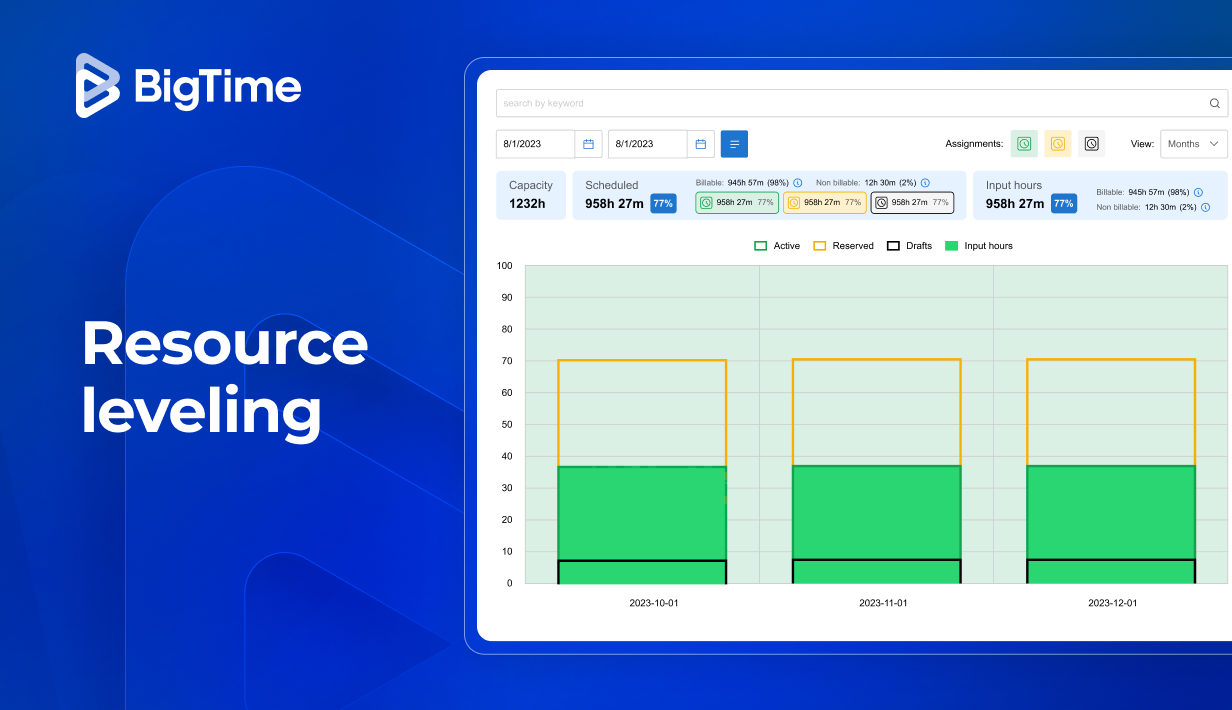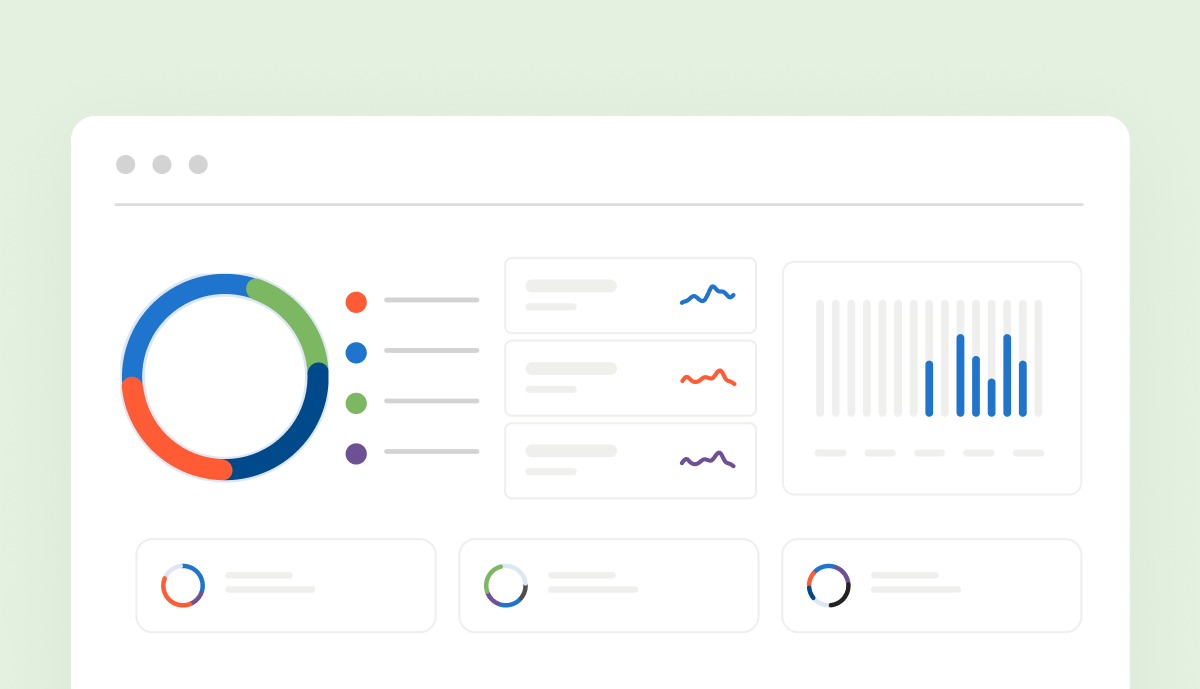Last update: June 14, 2025
Projects rarely go exactly as planned. Many of them fail due to the unexpected obsacles in their critical path – and the majority of them is rooted in resource allocation issues. This is where resource leveling can give you a helping hand and show you how to resolve resource conflicts.
Regardless of the circumstances, resource leveling allows project managers to reallocate resources in line with your goals and objectives, all while being mindful of any resource constraints. With this technique, projects can be delivered on time without affecting the morale of your team. Still, resource leveling combines data from all corners of your business – and you need more than a spreadsheet to manage the process.
Sound complicated? Keep on reading to get a good grasp of every aspect of resource leveling.
What Is Resource Leveling?
Resource leveling is an incredibly helpful project management technique for resolving scheduling conflicts or overallocation with changes in resource allocation, plans and project timelines. It gives you the tools to adjust resource allocation or project schedules and avoid overextending your resources, keeping the quality of your deliverables high.
In other words, resource leveling is a balancing act where you have to find a sweet spot between the resource demand for the same resources across multiple projects and your goal. Sometimes that might involve keeping the project’s deadline. Other times, it might require you to dedicate just enough resources to the project with the option to push its end date a little bit into the future.
Resource Leveling vs. Resource Smoothing: What’s the Difference?
While both resource leveling and resource smoothing aim to help you manage limited resources without sacrificing quality, they take very different paths to get there. Knowing which to use, and when, can make or break your project schedule.
Resource leveling is your problem-solver when you’re staring down hard schedule conflicts or overallocation that would derail your plan entirely. It allows you to shift deadlines, change task dependencies, or even extend the project duration if that’s what it takes to resolve resource clashes. It’s flexible and realistic, because sometimes meeting the deadline isn’t as important as not burning out your team or blowing your budget.
Resource smoothing, on the other hand, keeps your finish line exactly where you set it. Instead, it fine-tunes the schedule within the available float or slack to even out the workload. It’s the art of balance without compromise on project completion date, ensuring your team works at a sustainable pace without changing your promise to stakeholders.
When To Use Resource Leveling Process?
Resource leveling is a solution to many problems with resource utilization. Still, in some cases, it might miss the mark, while in others it would certainly be a preferred solution to pressing issues.
It is generally advisable to use resource leveling:
- When you want to avoid spreading your resources too thin and still ensure that your team has all the skills it needs to complete critical path tasks
- When you want to prevent significant project delays and minimize losses in labor and cost.
- When you want to take case of work life balance in your company and prevent overallocation that leads to overwhelming workloads for your team members and affects their level of motivation.
- When you want to manage resources and client expectations by keeping the same level of quality for all the project deliverables.
- When managing your resources is simply becoming more and more difficult. You’re dealing with double bookings and over allocations all the time. You’re not sure who is working on which project. You’re constantly getting asked about that and spend a lot of time in meetings dedicated to updating PMs about your resources. Resource leveling might be the solution to all of those problems.

Top Resource Leveling Techniques
Even the best-laid plans can unravel when resources are stretched too thin. That’s why understanding these tried-and-tested resource leveling techniques is key to keeping your project on track, your team motivated, and your clients satisfied. Here are the most popular of them.
Critical Path Method
The Critical Path Method (CPM) helps you identify the sequence of tasks that directly determines your project’s duration and deadlines. With this resource leveling technique, you can see which tasks can be delayed without impacting the overall schedule by analyzing project dependencies and durations, creating “critical path” for the most important objectives.
Based on the information on project finish date and critical tasks leading to its execution, project managers can determine the “float”, or scheduling flexibility indicating the maximum delay a task can experience before putting the entire project at risk of significant delays. In other words, it’s your buffer zone, or the space you have to maneuver without consequences.
To calculate float, you look at two key dates for each activity: the Early Start (ES) and Late Start (LS) (or Early Finish and Late Finish). The formula is straightforward:

While float tells project managers how much wiggle room they have for a particular task, it can’t be used for tasks on critical path. Since all the resource dependencies in project scope are rooted in them, any changes to their execution might result in catastrophic consequences. In short, delay them even a little, and the whole project slips.
Critical Chain Method
The Critical Chain Method (CCM) is a resource leveling technique goes beyond task dependencies and looks at your resource constraints head-on. It adds buffers to protect the schedule from delays and keeps teams focused on priority work without overloading them. By accounting for resource limits and building in realistic margins, CCM is your insurance policy against the surprises that can sabotage your timeline and overextend your team.
Fast Tracking
Fast Tracking is the bold move when you need to compress your schedule without sacrificing scope. It means performing tasks simultaneously that would normally be done in sequence. While it comes with risk – more overlap can mean more coordination headaches – it’s a powerful way to buy time when deadlines are non-negotiable.
While this resource leveling technique requires careful planning and clear communication, but done well, it keeps your project competitive and on time. Still, in more complex environments, this schedule compression technique might be a step too far – especially when your project plan is already a stretch.
Crashing
Crashing is your last-resort resource leveling method for pulling a slipping schedule back on track. It involves adding extra resources to critical tasks to shorten their duration. It requires more people, more hours, or more budget – whatever it takes to meet the deadline.
Crashing is not always the cheapest option, but when time is truly of the essence, crashing is how you show your clients you can deliver, even when things get tough. Still, it might make balancing demand difficult, with uneven allocation being almost a certainty in case of fixed time constraints.

3 Real-Life Resource Leveling Examples
How does resource leveling work in practice? To help you get a clearer picture of what the process is all about, here are three resource leveling examples that apply to a professional services company like yours.
Example 1: Getting Additional Resources on Board
Picture a team receiving several edits from the client, requiring a significant amount of time to address.
The current team doesn’t have the resources to respond to this problem on its own. So, more resources – in this case, two new members from other teams – temporarily join in to help fix the problem.
Example 2: Delaying the Project Start Date
Let’s imagine a team that requires a designer to create mockups for the client to accept.
But it turns out that the designer was double-booked and is currently busy working on another project on a full-time basis.
What can we do to make it work and not delay the project? We can start the project a few days later, once the designer becomes available.
Since the designer is experienced and works fast, the product still has a high chance of being delivered by the deadline.
Example 3: Postponing the Project End Date
Imagine a team that’s building a certain custom product. To make it work, team members need to be in touch with a certain unit on the client side that includes two people. It just so happens that one of the specialists is out of the office due to illness, and the other one is on holiday leave.
Luckily, the second specialist will be back in the office within a few days. So, your team can jump onto another project while waiting, and you extend the project deadline by a few days.
It doesn’t matter what kind of teams you lead — resource leveling will come in handy for resolving all kinds of resource conflicts.
3 Resource Leveling Best Practices You Should Know About
Predict Resource Availability
If you don’t have the right resource allocation tools, predicting the availability of your employees is next to impossible. And you’re not going to get away with Excel spreadsheets here, even if you’re running a relatively small professional services company.
To make the most of your resources and have full control over their utilization, you need to gain more visibility of how they’re being used across projects. Resource management software is going to be the best solution for seeing how your business is doing from a higher level.
Compare Your Initial Project Estimations to Real-Life Allocations
Start by creating tentative project allocations (trust us, it’s worth doing that as soon as you can). You can compare them to your initial estimates and optimize them to make the data accurate. When the project is booked, and you’re sure about these allocations, simply change them to “active” (hard booking, rather than a soft booking).
Sometimes, you might only need to allocate people for some portion of their capacity or only for a certain number of hours on specific days. The solution you’re using should allow you to handle these use cases smoothly.
Have Backup Plans for New Hires and Existing Employees
Once you know which employees will be assigned to your project, your PM can start assigning them to specific project tasks. Always have a backup plan in case a resource suddenly becomes unavailable (for example, due to illness or when a brand-new hire gets a better last-minute offer and jumps ship).
For critical positions, always hire people a little earlier to make sure they’re available when the project starts. If you assign an existing employee, make sure to have a backup resource in place who could do the job for a week or more when the project kicks off.
Simplifying Resource Leveling
Without specially designed project software, resource leveling might be a tedious process. Fortunately, project management software can turn this responsibility into a quick task – and BigTime is one of such solutions.
With BigTime, you can:
- See the available resources instantly, along with their skills, qualifications and utilization rates.
- Create project and resource plans in Gantt charts with drag-and-drop edits.
- Translate working hours into costs, and costs into project budgets – it will happen automatically!
- Avoid resource overallocation – our system will notify you any time an error occurs.
- Update tasks automatically, whenever you – or any of your colleagues – make a change to any of the existing allocations.
- …and much more.
Book a demo with BigTime to see what you can achieve with data-driven insights.




